#1950's tokusatsu
Explore tagged Tumblr posts
Text

Genderflipped heroes.
#giga#sentai#toei#kamen rider#gekko kamen#kousoku esper#android kikaider#rainbowman#henshin ninja arashi#condorman#choujin bibyun#megaloman#metal heroes#gender flip#micro comparisons#shoutarou ishinomori#showa era tokusatsu#heisei era tokusatsu#1950's tokusatsu#1960's tokusatsu#1970's tokusatsu#1980s tokusatsu#1990's tokusatsu
5 notes
·
View notes
Text

Moonlight Mask.
#showa era tokusatsu#moonlight mask#gekko kamen#toei#kohan kawauchi#1950's tokusatsu#1970's anime#1980's tokusatsu
9 notes
·
View notes
Text
Taking a brief look at Dinosaurus! (1960)
There's barely any coverage of this film on this site so I guess I'll rectify that.

Dinosaurus! (Yes the exclamation point is part of the title) is one of those middling science fiction films of the 1950's/1960's that's hard to recommend if you aren't a child or already a genre enthusiast looking for more stuff to watch that isn't terrible, but there's enough fun to be had.

The film takes place on an unnamed Carribean island where an American construction company is building a harbor, and the deepsea explosives they use unearth two frozen dinosaurs, a Tyrannosaurus and a Brontosaurus, who are then revived that night by a bolt of lightning alongside a caveman also freed from the ice, henceforth everyone on the island has to rush and make defenses against being stuck here with no communication infrastructure available.

I think of immediate notice is that Dinosaurus! is in color and wide-screen, an absolute luxury for an independent monster movie from the turn of the decade and probably the most noteworthy thing about the film as a whole. It really lets the island setting, shot on location, come into its own as the blues and greens look remarkable, especially when contrasted with the reddish colored Tyrannosaurus.

You may have noticed I glossed over discussing any characters in the plot synopsis and that is unfortunately because they mostly exist for plot functions and might as well be caricatures from future genre parodies. Ward Ramsey as Bart might be the only time a genuine stereotypical "square jawed hero" proper would be seen in a film like this, essentially doing the majority of heroic actions in this film. Kristina Hanson's Betty is the woman, Fred Engleberg's Hacker is the malicious greedy person who makes the situation with homicidal monsters on the loose more complicated than it needs to be, so on and so forth. The highlights might be Alan Roberts as Julio, a kid who knows more about dinosaurs than anyone else present and befriends the Brontosaurus and caveman (a genre archetype much more common in tokusatsu than western monster movies) and Gregg Martell as the eponymous caveman, who derails the film for minutes at a time in comedic hijinks of how a prehistoric human doesn't know what glass or a radio or paintings are. Though the film boasts something like half a dozen fucking comedy relief characters, the caveman actually transcends the future tired gag it would become by actually getting into the action to defend against the Tyrannosaurus. Dinosaurus! is also the only film of its type that features a substantial number of afro-latinx people though shamefully they're almost entirely relegated to background non-speaking roles.

The film is more or less structured around key special effects sequences such as the dinosaurs coming to life, the Tyrannosaurus attacking a bus, the two dinosaurs fighting, the Tyrannosaurus trying to eat people hiding inside a cave, and the Tyrannosaurus fighting an excavator on a cliffside. Both dinosaurs are realized through a combination of stop motion and puppetry and they're both damn good, largely thanks to the nuanced slimey coloration and skin texture on both of them. The Tyrannosaurus gets primary focus given that it actually kills and eats people versus the Brontosaurus mostly just moseying about.

It would be too harsh to call Dinosaurus! "forgotten" especially in the context of it getting a 4K restoration and a Blu-Ray release but it's now mostly known for individual scenes (mentioned above) being likely forerunners to key moments in films such as Jurassic Park (1993) and Aliens (1986). Dinosaurus! might actually be the best dinosaur film to come out in the extensive period between King Kong (1933) and Jurassic Park, though that's much more an indictment of the quality of every other dinosaur film for 60 years than an appraisal of Dinosaurus!' own quality. I can personally vouch for the fact that this is better than either Ray Harryhausen film starring dinosaurs at least.
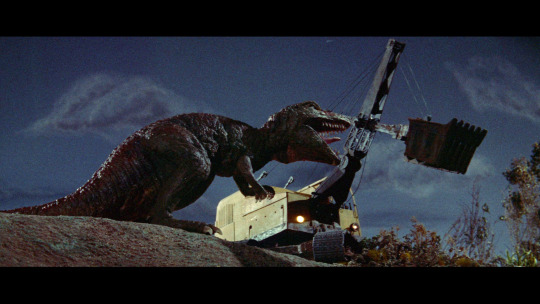
16 notes
·
View notes
Text
An Abbreviated History of Mecha Part 1: The Mighty Atomic Prelude (The 50's and 60's)

Welcome to An Abbreviated History of Mecha anime. Today, we're starting at, as Fraulein Maria would say, at the very beginning. We're taking a quick peak at the beginning of the canon, which means that we're starting back in 1950 (specifically 1952). I should also confess right now: there are two series on here that are demonstrably NOT mecha shows. However, due to their sheer influence on Japanese media as a whole, I feel it is important to bring them up as being honorary mecha shows due to their sheer influence pop culture.
Tetsuwan Atom/Mighty Atom/Astro Boy (1952)

Starting us off is Osamu Tezuka's seminal manga series, Mighty Atom. Known over here in the west as Astro Boy, this series would be what kickstarts a lot of the modern anime and manga industry due to its sheer popularity. Astro Boy would also be one of two series that would be emblematic of how Japanese pop culture would portray the recent use of atomic energy. It should also be worth noting that realizing that Astro technically is a mecha is what got me to start using a broader definition of mecha instead of the classic giant robot definition.
Due to its fame, Mighty Atom has receive multiple adaptations throughout the years. Of note are:
The original 1963 anime.
New Mighty Atom (1980) which updates the series to 1980's animation standards.
The 2003 anime, which does the same, but to the standards of early 2000's anime.
The 2009 CGI movie.
Gojira/Godzilla (1954, honorary mecha series 1)

1954 would also give us Ishiro Honda's Godzilla, the movie that would make tokusatsu-styled live action stories in Japan. Godzilla, alongside RKO's King Kong, would play a large part in popularizing the concept of kaiju. And boy will kaiju play a big part in the history of the mecha canon. As we'll see soon enough, the history of tokusatsu heroes, kaiju, and robots are all intertwined with one another.
Godzilla has starred in numerous movies since the original, but for stories based off of the original there are:
Godzilla Raids Again (1955), a direct sequel.
Godzilla, Mothra, King Ghidorah: All Out Monsters Attack (2001), a Heisei-era production that uses the original '54 Godzilla as a manifestation of the horrors of World War II.
Shin Godzilla (2016), a re-imagining of the original movie set in contemporary times directed by Hideakki Anno.
Godzilla Minus One (2023), the most recent outing inspired in part by GMK.
Tetsujin 28-go/Gigantor (1956)

(Oh hey, this gif again!)
Tetsujin 28-go is the creation of one Mitsuteru Yokoyama and is generally regarded as the grandfather of the giant robot style of mecha. Tetsujin is unique amongst mecha in that it is controlled not by a pilot riding inside of it, but by a little kid with a controller. Tetsujin 28, alongside Mazinger Z, would help to codify a lot of the tropes common to the classic superhero mecha anime that would be prevalent in the 70's. Like Mighty Atom, Tetsujin would receive multiple adaptations throughout the decades.
Shin Tetsujin 28-Go/The New Adventures of Gigantor (1980), which updates Tetsujin's design to look more in line with something like Mazniger Z.
Tetsujin 28-go FX (1992), sporting a radically different look that's more akin to something out of the Brave Franchise.
Tetsujin 28 (2004), a faithful adaptation of the original manga (at least I think it is) directed by Yasuhiro Imagawa.
Cyborg 009 (1964)

Created by Shotaro Ishinomori in 1964, Cyborg 009 is another classic human-sized mecha series. Cyborg 009 would be the first of many hits for Ishinomori, and he will be mentioned again later in this series.
Oh boy... I am not a Cyborg 009 nut, but in terms of adaptations, Cyborg 009 has:
The 1966 Film
The 1980 Film
009 Re:Cyborg (2012)
The Call For Justice Trilogy (2016)
The 1968 Anime
The 1979-1980 Anime
The 2001-2002 Anime (I actually remember when Toonami aired this series!)
Cyborg 009 vs Devilman (2015 OVA)
If you want to follow someone who follows a lot of Shotaro Ishinomori's works, I'd recommend checking out YouTuber Mercury Falcon for more info about Ishinomori.
Ultra Q and Ultraman (1966, honorary mecha series 2)

(The urge to use a gif of Ingraman is strong)
Ultra Q and Ultraman are the first two entries of Tsuburaya's legendary Ultra franchise, with the latter in particular being one of the most famous pop culture icons of all time. Ultraman's influence on Japanese media is so large, that I'll be mentioning it at least once in relation to other series later on.
Ultraman, like Godzilla before him, would get the Hideaki Anno treatment with Shin Ultraman in 2022.
Giant Robo/Johnny Sokko and His Flying Robot (1967)

Another one of Mitsuteru Yokoyama's classic manga series, Giant Robo deserves a mention due to its influence on tokusatsu. Giant Robo would usher in an era of tokusatsu that would rely on using giant robots as the main protagonist.
In terms of adaptations, there are two animated adaptations, but only one will be listed here:
GR: Giant Robo (2007)
If you want to learn a little bit more about the history behind Giant Robo, I'd recommend checking out blunova's video on Giant Robo for more info on this important series.
Conclusion
As the 60's would lead way into the 70's, we would see a lot more live action tokusatsu series involving giant robots. Of course, this would be untenable due to how expensive it was to do tokusatsu effects for television. However, one robot would appear in animation that would change everything.
(Read in the voice of Tessho Genda) AND ITS NAME IS...!!!!

#anime and manga#mecha#astro boy#mighty atom#tetsuwan atom#gigantor#tetsujin 28#cyborg 009#giant robo#ultraman#an abbreviated history of mecha#anime history#godzilla#gojira
51 notes
·
View notes
Photo
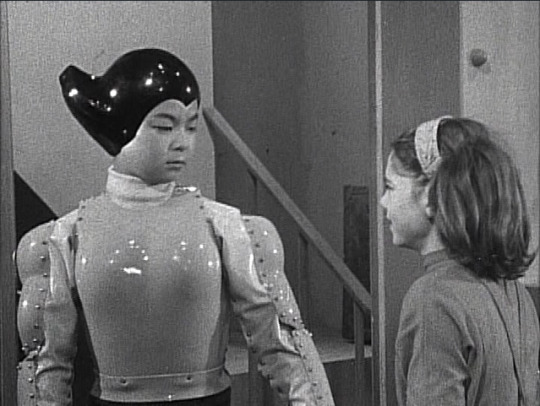
Mighty Atom (Tetsuwan Atom) aka Astro Boy, meets an alien lifeform in his 1959 television series.
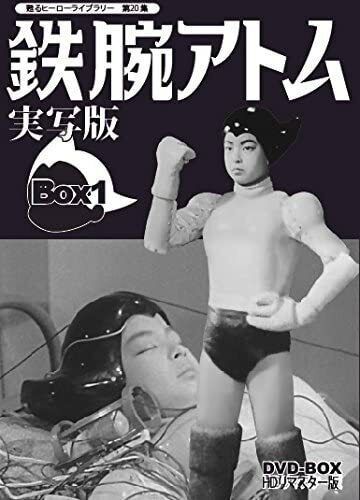
The Mighty Atom/Tetsuwan Atom series was the first attempt at bringing Osamu Tezuka’s wonderful boy robot to the screen. Tezuka-san himself, however, reportedly was not impressed with the live-action show.

The 1950′s version of “You Can Call Me On Your Cell Phone”
His dissatisfaction was due to the series not being as science fiction based as the original manga; instead Mighty Atom mainly battled gangsters and ordinary thugs. Not a dissimilar complaint to that lodged against the Adventures of Superman television series.

Tezuka-san’s dislike of the live-action version of Mighty Atom led him to vigorously adapt his manga as an anime. Thus, in 1963, the enormously popular Mighty Atom/Tetsuwan Atom anime series debuted in Japan. It was also dubbed and released in the United States as Astro Boy.
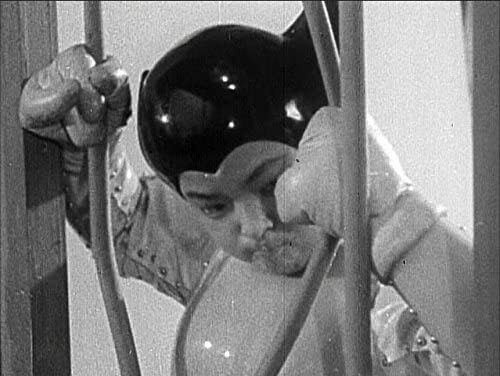
Tezuka-san’s distaste for the live-action show remained strong. He was trepidatious when approached a couple of years later to adapt his manga Ambassador Magma into a live-action series. Tezuka-san did not think Ambassador Magma would do well in that format, and suggested the producers use another character of his.
Luckily for us, Tezuka-san was successfully persuaded and the result was Ambassador Magma (aka The Space Giants), the first color tokusatsu superhero show on Japanese television (beating the original Ultraman series to the small screen by 6 days). Tezuka-san was reportedly very, very happy with the series.
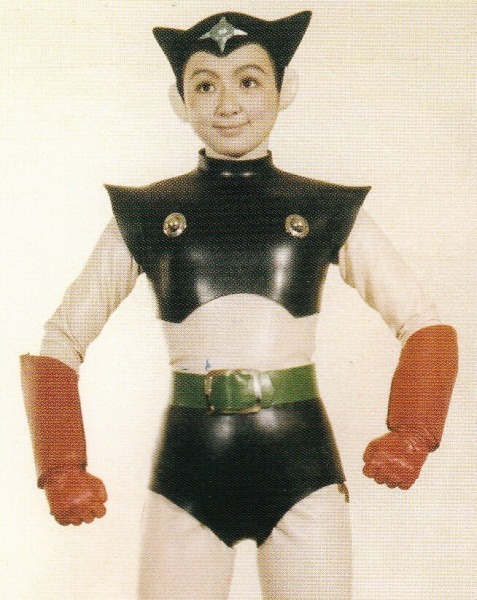
Which then leads us to 1972, 4 years after the Mighty Atom manga ended. A production company floated the idea of another live-action Mighty Atom series (probably to take advantage of the tokusatsu hero boom at the time on Japanese TV). Atom would be wearing an updated costume, which I think appeared in the manga, but I’m not sure; I haven’t read all the volumes yet.
Even more interesting, though, is that Atom would be played by a girl!
I don’t know much more about this proposed series beyond the fact that it never came to fruition. If anyone has additional information I’d be much obliged if you’d share it with me and the rest of the class.
youtube
121 notes
·
View notes
Text
10 Best Sonny Chiba Movies You Need to Watch Right Now
https://ift.tt/eA8V8J
On August 19, 2021, legendary Japanese actor Sonny Chiba succumbed to complications from Covid-19. He was 82. If you don’t know Chiba, he was a pioneering martial arts movie stars and a genuine master of the martial arts. Long before Bruce Lee, there was Sonny Chiba.
Chiba was his stage name. He was born as Sadaho Maeda and adopted “Chiba” after Japan’s Chiba prefecture where he grew up. His Japanese stage name was Shinichi Chiba, but he was known internationally as Sonny.
Chiba was a natural athlete and a contender for Japan’s Olympic gymnastics team until he was sidelined by an injury. He pivoted to study Karate under the venerated master Mas Oyama, a hardened full-contact fighter who was famous for killing bulls with his bare hands. Chiba went on to earn black belts in several schools of Karate, as well as Judo, Kendo, and Ninjitsu.
In the 60s, Chiba began his acting career in television, specifically in the costumed superhero genre known as tokusatsu (think Ultraman or Mighty Morphin Power Rangers). From there, he jumped to crime thriller movies and quickly established himself as an action star. In 1970, he formed the Japan Action Club, one of the first groups dedicated to stunt people and martial arts actors. His first explicitly martial arts film part was in 1973 in a film called Karate Kiba.
Chiba is credited with over 200 roles, predominantly in Japanese martial arts films, however he’s appeared in a few Hollywood projects. While he’s known in the west for his martial arts performances, he’s delivered a wide range of characters, mostly leaning towards grindhouse cinema. Since 1959, Chiba has delivered several projects almost every year. The bulk of his work over the last two decades were direct-to-video projects. His final film Bond of Justice: Kizuna, a Yakuza revenge tale, is in post-production and is slated to be released later this year.
In honor of Sonny Chiba’s illustrious career, Den of Geek has cherry-picked several of his best and most interesting films.
Invasion of the Neptune Men (1961)
Since Chiba got his start in tokusatsu, we had to include at least one title from this uniquely Japanese genre, and this one is truly vintage, shot in black and white. Chiba plays an astronomer with a secret superhero identity. He transforms into Space Chief, a caped crusader clad in a metal helmet and sunglasses who is a friend to little children. Meanwhile, the titular Neptune Men are dressed in classic 1950s-style alien costumes, all silvery with ridiculous bucket-like helmets. Yes, this is one of those films that’s so incredibly bad that it’s good, so much so that it caught the attention of Mystery Science Theater 3000, which is the best way to watch it.
The Street Fighter (1974)
The Street Fighter was a game changer, one of the very first modern Japanese martial arts films to get international distribution. Riding on the wake of one of the first globally distributed Chinese martial arts films, Five Fingers of Death (1972), The Street Fighter established Chiba as a martial arts star in the eyes of the world. If you’re only going to watch one Sonny Chiba movie ever, this is the one. It was the defining role of his career.
Chiba plays the antihero Teri Tsurugi, whose nickname is “Real mean bastard.” It’s a gratuitously violent film for the time, unapologetically so with Tsurugi ripping out throats, breaking necks with wild abandon, and selling women as sex slaves, often while shirtless to show off his macho barrel chest. When The Street Fighter was released in the U.S., it was the first film to get an X rating for violence.
Chiba reprised the role twice in 1974 with Return of the Street Fighter and The Street Fighter’s Last Revenge. The franchise also spawned a spin off trilogy, Sister Street Fighter, starring another genuine martial artist and actress, Etsuko Shihomi. Shihomi frequently starred alongside Chiba. She appeared in Karate Kiba and its sequel, as well as in the original Street Fighter films. Chiba appears in Sister Street Fighter, but as a completely different character than Tsurugi.
Wolf Guy: Enraged Lycanthrope (1975)
This is not a Mystery Science Theater film, but it should be. Wolf Guy is a hard-to-find cult film where Chiba plays Akira Inugami, the last survivor of a clan of werewolves who uses his lupine powers to solve crimes. However, when the moon triggers him (or a comet or the birth of a two-headed calf – Inugami is easily triggered), Inugami doesn’t transform into a hairy beast. He just gets super wolf powers. It’s a strange film, not for everyone except for those who love psychotropic Japanese cinema.
Note that the Japanese title of this film is Urufugai and that’s a phonetic translation of “wolf guy.” “Urufu” is “wolf’ and “gai” is “guy.” This is an example of wasei-eigo, literally “Japanese-made English.” “Anime” is another wasei-eigo term, derived from the English word “animation.” The Japanese title of Karate Kiba is Bodigaado Kiba – Bodigaado is “Bodyguard.”
Karate Bullfighter aka Champion of Death (1975)
Chiba played his illustrious sensei Masutatsu “Mas” Oyama in a film trilogy based on a biographical manga titled Karate Baka Ichidai (Karate fanatic) by Ikki Kajiwara that began in 1971 and ran until 1977. Karate Bullfighter was the first. Karate Bearfighter came out the same year and Karate for Life was two years later. There’s also an anime version of the manga that came out in 1973. The manga and anime are credited with stimulating a Karate trend in Japan.
Oyama Sensei had cameos in the first two films. Oyama was Korean, born in Korea while it was under Japanese rule. His birth name was Choi Yeong-eui, but he changed his name after immigrating to Japan in 1938. He died of lung cancer in 1994.
Golgo 13: Assignment Kowloon (1977)
Based on the popular manga series, launched in 1968 and still running to today, Golgo 13 is Japan’s answer to James Bond. He’s an international assassin, a crack shot sniper with Karate chops. Chiba plays Golgo 13 on a mission to sanction a Hong Kong crime boss. This is a classic ’70s grindhouse film, and Chiba captures Golgo 13’s cold-blooded ruthlessness with his signature vicious aplomb.
Message from Space (1978)
In the wake of Star Wars, Message from Space was a blatant rip-off with a tokusatsu bent. It had Japan’s biggest budget at the time, but you wouldn’t know it now. It’s horribly dated with cheesy special effects, another “so bad it’s good” movie — Mystery Science Theater could have a field day with Chiba’s filmography. Chiba and his street fighting counterpart Etsuko Shihomi shared top billing alongside Vic Morrow.
Hunter in the Dark (1979)
We had to include one of Chiba’s period films, and Hunter in the Dark is a fine example of the samurai genre. Led by one of the greatest samurai film actors of all, Tatsuya Nakadai, and directed by the influential Hideo Gosha, Chiba is in a supporting role as Shimoguni Samon. When the grindhouse films get too much, this is a welcomed change — an unsung masterpiece by some of the leaders of the samurai genre.
The Storm Riders (1998)
The Storm Riders was another gamechanger, an epic Chinese fantasy martial arts film based on the manhua by Ma Wing-shing (manhua is Chinese comics like manga is Japanese comics). Starring Ekin Cheng and Aaron Kwok, this special effects-driven film won many accolades at Asian film festivals and ushered in a new era for the period martial arts fantasy film genre known as wuxia. Chiba played the villain, Lord Conqueror.
Kill Bill: Volume 1 & 2 (2003 & 2004)
Quentin Tarantino cast Chiba as Hattori Hanzo, the retired swordmaker and sushi chef who created the Bride’s (Uma Thurman) katana. It was an homage role. Tarantino was paying respects to Chiba as a longtime fan. He also inserted easter eggs honoring Chiba’s work in Pulp Fiction. When Jules Winnfield (Samuel L. Jackson) claims to quote Ezekiel 25:17 – “The path of the righteous man…” – it’s a reference to the opening of Karate Kiba, which paraphrases the same passage in the American version.
The Fast and the Furious: Tokyo Drift (2006)
Chiba played Kamata, a yakuza boss and the father of the films main rival. Like with Kill Bill, Chiba’s Hollywood roles are the most cited in his obituaries, but both were minor in comparison to his vast and diverse body of work.
A prolific actor who did most of his own stunts long before Jackie Chan claimed to do so, Chiba was a cinematic maverick who attacked moviemaking with an unprecedented and unapologetic sense of ultraviolence. While many of his films seem dated and low brow now, his impact on action film is undeniable and his passing marks an incalculable loss to the genre.
cnx.cmd.push(function() { cnx({ playerId: "106e33c0-3911-473c-b599-b1426db57530", }).render("0270c398a82f44f49c23c16122516796"); });
The post 10 Best Sonny Chiba Movies You Need to Watch Right Now appeared first on Den of Geek.
from Den of Geek https://ift.tt/3ke3huG
1 note
·
View note
Text
Kamen Rider 45th Anniversary File: Shotaro Ishinomori

1938:
Superman debuts in Action Comics #1
Walt Disney establishes himself as a leading pioneer of animation with the first full-length feature film Snow White and the Seven Dwarfs.
King Kong Appears in Edo, a jidaigeki take on America’s 1933 King Kong film debuts and is one of the first kaiju/tokusatsu films in history. It is sadly also a lost film as all prints are believed to have been lost or destroyed during the war. The only evidence of its existence are old movie posters, some production photos and archived magazines.
Eiji Tsuburaya briefly works at the Tokyo branch of Toho Studios as head of the Special Visual Effects department, but later leaves and works on war propaganda films for the Japanese government.
Hitler assumed absolute power over Germany by overthrowing the established government. World War II is fast approaching as this evil man spread his philosophies of death, chaos and madness.
The Great Depression hits even harder after almost a decade around the world and would not let up until 1941 and officially end by the late 40s and early 1950s. (though a recession would hit in ‘58)
Japan was at war with China.
And while the world braced for more doom, death and gloom and seeing the absolute worst in humanity....
On January 25th, 1938, Kashiku Onodera and Kotaro Onodera welcomed the newest member of thier family: their second oldest child Shotaro. The Onodera family would later consist of five brothers and an older sister named Yoshie.
Young Shotaro grew up during the second World War and by middle school would be something of a curious artist. He would make manga of his own and his first one published was in 1954 with Second Class Angel. This hobby eventually paid off in 1955 when he got an assistant job from...

Osamu Tezuka!
His tasks were to help the cartoonist on various manga, most notably a story in Tetsuwan Atom aka Astro Boy.
When not working with Tezuka, Ishinomori would do his own manga adapting classic literary works. Some of the novels would later inspire him for his creations, such as Akumaizer 3, his own wild spin on the Three Musketeers.
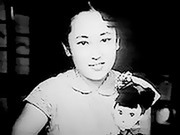
While he was a good artist, his family was less than supportive of his work aside from his big sister Yoshie. She was always there for her little brother and cheered him on, even inspiring him to draw. She even visited him while he worked in the Tokiwa-so building in Tokyo and hung out with his fellow artists. Which is all the more tragic, as she died in 1958 from complications of asthma at only 23 years of age.
This tragedy and the inability to do anything to save her life haunted Ishinomori and some of his female characters are loosely based on the kind of person she was or had bits of her character traits. So in essence, the Pink Rangers, at least in spirit, just may possibly have a part of her that resides in the heroines of Sentai and indirectly; the Morphin’ Grid. Female heroes such as Tackle (whose actress also sadly died of an asthma attack) also could be influenced by the kind of personality she had when she was alive.
On July 19, 1964, Shotaro created Cyborg 009, which launched him into super stardom.
On April 3rd, 1971, he hit the big time by teaming up with Tohru Hirayama to create Kamen Rider.
From there, he became synonymous with Super Heroes. But Ishinomori was a jack of all trades, he also did dramas, love stories, crime stories, Shoujo, ninja etc. So calling him “The Stan Lee of Manga” while somewhat factual in terms of superheroes, is kind of an insult to his prowess as he was more expansive in versatility than that.
Originally going by Ishimori, Shotaro changed it to Ishinomori in 1985 to celebrate 30 years of working in the media industry.
His influence is just as great as Tezuka, among those who worked for him were:
A young animator named Hayao Miyazaki in the 1960s worked as an artist on some of Ishinomori’s animated films.
Go Nagai, a student of his and an assistant. Later became a legend in his own right after leaving him in 1967 to create Mazinger Z, Cutie Honey and most famous of all, Devilman! Go Nagai once appraised in an interview that his mentor had a drawing ability that bordered on being superhuman as “He was a genius who could draw five times faster than the average adult artist.”
Kazuhiko Shimamoto
Takao Aoki, the creator of Beyblade (worked on a short story featuring RX and ZO and on the Kamen Rider ZO TV-Kun manga)
Ishinomori was also a lyrical composer, as some of the songs in Kamen Rider were written by him. Even fan favorite songs of his other works such as Taga Tame Ni from the ‘79 Cyborg 009 anime was written by him.
ForestofStone can explain his life a lot better than I can (Credit to her for some of this interesting info!):
http://forestofstone.tumblr.com/post/125974267909/shotaro-ishinomori-the-king-of-manga
Cameos
Despite being in manga, anime and TV, Ishinomori originally wanted to be a filmmaker and went on trips to see landmarks and observe the world around him for inspiration. This gave him better insight into people and inspired his drawings in some cases.
He even decided to take a page from Alfred Hitchcock and make cameos in his TV shows and films:
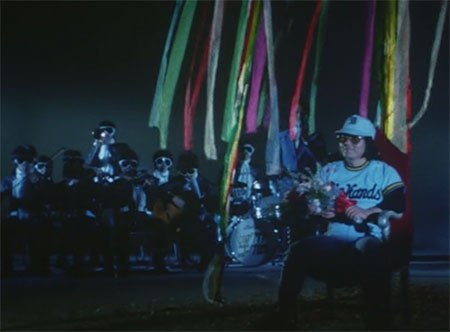
Kaiketsu Zubat Ep. 10: A Baseball player
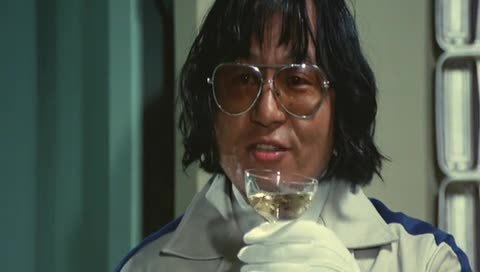
A guest on a luxury cruise in the film Eight Riders vs. Galaxy King.

A Fisherman who gets killed by the monster of the week in episode 84 of the original Kamen Rider.
He also cameoed in video games:


A fisherman in the Kamen Rider Black Movie Hurry To Onigashima. Now sporting a ‘stache with his trademark afro.
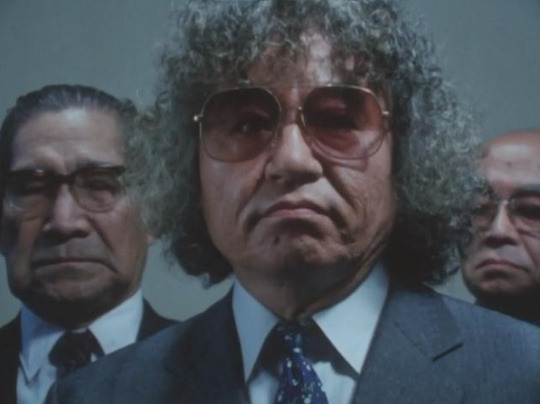
His final living cameo in Shin Kamen Rider Prologue as a spy eavesdropping in on the Foundation.
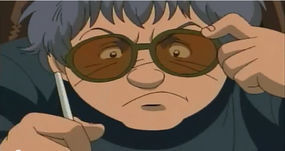
Even after he died, he still is a presence in the works he created. In Cyborg 009: The Cyborg Soldier he appears and interacts with Professor Gilmore (though voiced by someone else).

Shotaro Ishinomori, as drawn by his biggest fan Kazuhiko Shimamoto in a manga.
Of course, all life must end. It is the biological entropy of the universe we can never fully escape as we all must go at some point. And such a creative talent was taken from us far too soon.
But the late Mr. Ishinomori now has two museums made in his honor, a Guinness World Record posthumously awarded for the most comics drawn by a single author, tons of manga artists who view him as a role model and a growing amount of respect from artists in the American comic book industry.
1998:
Seiju Sentai Gingaman debuts
Ultraman Gaia airs, created by future Digimon Tamers head writer Chiaki J. Konaka
Kids around the world were crazy ‘bout the Pokeymans, some of which were inspired by the Kaiju of popular films in design.
Disney celebrates 60 years of making animated films with their latest feature Mulan.
Superman turns 60 and is sporting an electric blue costume (with a cool shield design but lacking his trademark powers).
Power Rangers in Space airs.
Megaranger vs. Carranger hits VHS
Rebirth of Mothra III, the last entry in the Rebirth of Mothra series premieres in Japanese theaters.
Ultraman Tiga & Ultraman Dyna: Warriors of the Star of Light acts as the first Heisei film crossover of Ultras and premieres in Japanese theaters.
America made a Godzilla movie. This was a terrible mistake and made a lot of people angry. It also had that Taco Bell dog promote the film by doing a commercial or two. HEERE LEEZARD LEEZARD LEEZARD!
Often fans wonder what would have happened had he lived into an older age.
Well for starters, Kamen Rider would be vastly different given some of his concepts and that Bijinder movie would have been made. Cyborg 009′s story possibly would have been completed over a decade earlier.
Jerry Robinson of Batman fame would have done a crossover with Kamen Rider, having met Mr. Ishinomori in Japan and proposing such in 1996, with possible further collaborations with DC Comics when they had the manga imprint CMX. Shotaro could have taken advantage of Japanese media coming in droves to the US during the 90s Anime boom to do new projects exclusively for America.
So many possibilities, but none can come to pass. But let’s not focus on the “What if’s”, let’s focus on the man’s legacy and pay our respects.
Here’s to you Mr. Ishinomori, without you there would be no Kamen Rider or Power Rangers. Thank you so much for giving us a wonderful world of characters and stories and I’ll do my best to pass them onto others so they too can tell them to the world! エクセルシオール Ekuserushiōru!
62 notes
·
View notes
Text
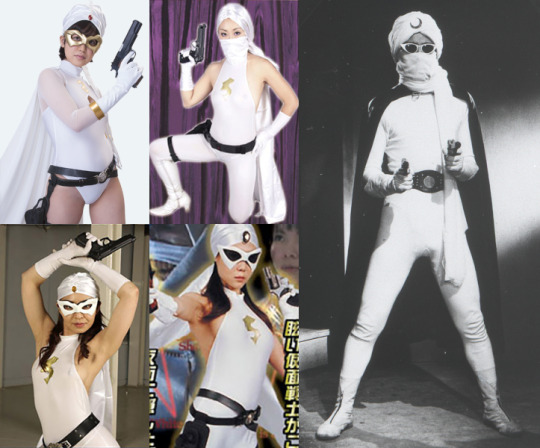
Gender flipped Gekko Kamen (1958).
#moonlight mask#gekko kamen#showa era tokusatsu#gender flip#giga#senkosha#kohan kawauchi#1950's tokusatsu
6 notes
·
View notes
Note
Hi I need to do some research about classic toku do you have some series that you would recommend

Sure and thanks for the second part as well, that narrows things down just a little bit.
If you are going to look to classic tokusatsu, you need to start at the roots and that’s the work of Eiji Tsuburaya. Tsuburaya pretty much pioneered what we think of as tokusatsu today through his work at Toho Studios in the 1950s and 1960s. Everyone known his work (if not his name) because he was the director of special effects for Toho classic kaiju films including 8 of their Godzilla films (though he was only supervising on 3 of the later ones). He also worked on tons of other movies and I highly recommend some of them such as Frankenstein Conquers the World (Frankenstein vs. Baragon), The Mysterians and Matango.

However, it is his TV work that I absolutely love. In the mid 1960s Tsuburaya decided to form his own production company and start producing high quality science fiction and fantasy programming for television. His first series was Ultra Q, a weekly show about mysterious happenings and monsters that brought the thrill of kaiju home to the masses that they usually had to go to the theater to see.

However, it was the follow up series, his first in full color, that really proved to be the huge hit he was seeking. That show started the Kyodai Hero (Giant Hero) genre of tokusatsu TV shows by introducing a gigantic superhero to battle the monsters and aliens that would appear each week. That show (and hero) was Ultraman.

I cannot stress how absolutely crucial Ultraman was to the history of TV tokusatsu. There had been heroes on TV before (such as 1958′s Moonlight Mask and 1960s National Kid) but nothing like Ultraman. It is the series responsible for kicking off the second kaiju boom and taking tokusatsu out of the movie theater and into homes on a weekly basis.
Though the first series is massively groundbreaking, I would actually venture that the second Ultra Hero show, Ultraseven, is the better series. It has a refined sense of storytelling, improved effects and better set designs than its predecessor. It also has my favorite hero of the franchise in the title character.

Fortunately, all three of these series are available on DVD in the US at reasonable prices (seriously, if you shop around the Ultraman DVD set can be bought for like $10).
With any success comes imitators and those came fast on the heels of Ultraman. Shows like Ambassador Magma*, Iron King and Spectreman flooded the airwaves until by the early 1970s there was a glut of giants rampaging Japanese airwaves.

Heck, Toho even threw their hat into the ring with shows like Ike! Godman, Ike! Greenman and Ryuusei Ningen Zone (Zone Fighter) the last of which tried to up the star power by bring in Godzilla as recurring guest star.

By this point though, there were just too many giant heroes and the formula was growing a bit stale. Tsuburaya could still get big ratings with Ultraman sequels but the derivatives were proving less and less popular with audiences.

That’s when the human-sized Henshin Heroes brought new life to the genre, starting with Kamen Rider. I won’t get into him too much as you already know his story and success but along with the Rider franchise came others, some from the same genius creator, Shotaro Ishinomori. These shows included the amazing Jinzo Ningen Kikaida (Android Kikaider) about a robot hero battling the evil organization DARK while protecting the children of his creator and searching for their Father who is wandering Japan suffering from amnesia after escaping the forces of darkness. It spawned a sequel, Kikaider 01 that told the tale of the main hero’s android brother, an earlier prototype.

There was also Akumaizer 3, the story of three demons who have escaped their service to evil to defend humanity from their former allies.

It also had a sequel called Choujin Bibyun, which featured heroes based off of rejected Kamen Rider designs! The three heroes here were the reincarnations of the heroes from the previous series.

Oh and for recommendations, I would be remiss without mentioning Kaiketsu Zubat, a very unique show about a man travelling Japan and battling evil to find the man responsible for the death of his best friend. It has a very interesting hero named Ken Hayakawa who may actually be more interesting out of costume than in!

There are so many more I could talk about here like the Go Nagai created series Star of Pro-Wrestling Azteckaiser and Battle Hawk.

However, I would be utterly remiss if I didn’t mention the series that lead to me creating this blog, the first of a franchise that’s lasted to this very day, Himitsu Sentai Goranger.

This was the very first of the the Super Sentai series (though it wasn’t called that at the time), the series that would come to rule the airwaves in the next decade (the 1980s).
This is really only scratching the surface. There are so many more shows I could go into but these really are the most important to the development of the art of tokusatsu on television. I hope this helps with your research and thank you for the question!
#Askbox Replies#Tokusatsu#Eiji Tsuburaya#Shotaro Ishinomori#Go Nagai#Ultraman#Godzilla#Ultraseven#Kyodai Heroes#Henshin Heroes#Kikaider#Akumaizer 3#Bibyun#Kaiketsu Zubat#Himitsu Sentai Goranger#1960s#1970s
97 notes
·
View notes
Note
Seeing more and more Ultraman being released on Crunchyroll, I feel more and more ridiculous calling myself a toku fan who doesn't watch anything Ultra. Where would you recommend I start?
Wow! Let me start by saying I know lots of toku fans who either don’t watch Ultraman or it’s just not their cup of tea. So, don’t feel too bad if you haven’t or even if when you do it’s not really your thing. Everyone has different tastes and it doesn’t make you less of a fan for not liking something that’s part of the genre.
That said, Ultraman is very much a bridge series between where tokusatsu was in the late 1950s and early 1960s (i.e. the Toho kaiju films such as Godzilla and his foes) and what became the more familiar tokusatsu TV heroes we have today (Kamen Rider, Super Sentai etc.) It took the giant monsters so popular at the time and brought them from the big screen to the small. The first to do so was 1966′s Ultra Q, which was a black and white Kaiju series with investigators exploring the strange and unusual with them usually ending up finding a monster. Think of The X-Files with kaiju.

This really isn’t essential viewing to get into Ultraman but it is fun and available on DVD in the US. What is also available and I would recommend is the very first Ultraman TV series, which followed Ultra Q in the same year. This where the superhero aspect was added, with the intergalactic lawman Ultraman arriving on Earth in pursuit of the alien Bemlar, merging with the Science Patrol member Shin Hayata and helping humanity fight monsters and aliens. It’s good stuff and gave us our first transforming hero who uses a device (the beta capsule) to change from human to giant when things get too tough for his crew.

The action is fun, the monsters creative and well done and it sets up the basic tone and theme of most of the Ultra series to follow. It’s also extremely easy to get your hands on and costs less than $10 for the entire series. Here is an Amazon link to the DVD set X.
On the other end of the spectrum, if you are watching on Crunchyroll, you can’t go wrong with the most recent series (last year’s) Ultraman Orb. Even though it is an Anniversary series, it’s pretty stand alone and has some of the most engaging characters I have seen in years. The basic setup involves a mysterious young man named Gai who comes to Tokyo just as giant monsters begin to attack. His enemy is a man named Juggler, who somehow has the ability to resurrect giant monsters beaten ages ago. When things get bad though, Gai can borrow the powers of previous Ultra warriors, combine them and become the mighty Ultraman Orb!

This series is one of the best and has a lot going on with secrets to be revealed, a possible romance for our hero and interesting links back to the older series as befits an Anniversary celebration.
However, if you are looking for a good, stand alone series that has no connections to any of the others you can’t really beat 1998′s Ultraman Gaia. The other series I have mentioned here share a Universe and are all interconnected, this series is set in a completely separate world and starts fresh and new. This is the story of Gamu Takayama, a geinus and member of a group of young science wizzes called the Alchemy Stars. During his personal experiments with a virtual tour of the inside of the Earth, he encounters a giant being and merges with it to become Ultraman Gaia. He joins the military organization XIG to use his genius (and secretly new powers) to fight off monsters and save the world from a predicted extinction level event.

Things get more complicated though when a second giant, Ultraman Agul, arrives on the scene. Is he a friend or a foe? I really recommend checking this one out because it’s a great show and will give you a feel for the Ultraman series in general without any of the backstory. It also has more modern effects and storytelling, feeling less episodic and stand alone than the original. Give this one a try and see if you like what Tsuburaya has to offer if you only want one show. It’s also available on Crunchyroll and is actually the series I am currently watching!
Thanks for the question and I really hope this helps!
#Askbox Replies#Ultraman#Tsuburaya Productions#Ultra Q#Ultraman Orb#Ultraman Gaia#1960s#1990s#2010s#Recommendations
35 notes
·
View notes
Text
@takkynoko @super-heroinecomparisons @super-saiyan-rose @jenndubya @tvnihonsubs @mrultra100 @oblivionbladetd @not-miles @saintheartwing

Genderflipped heroes.
#giga#sentai#toei#kamen rider#gekko kamen#kousoku esper#android kikaider#rainbowman#henshin ninja arashi#condorman#choujin bibyun#megaloman#metal heroes#gender flip#micro comparisons#shoutarou ishinomori#showa era tokusatsu#heisei era tokusatsu#1950's tokusatsu#1960's tokusatsu#1970's tokusatsu#1980s tokusatsu#1990's tokusatsu
5 notes
·
View notes